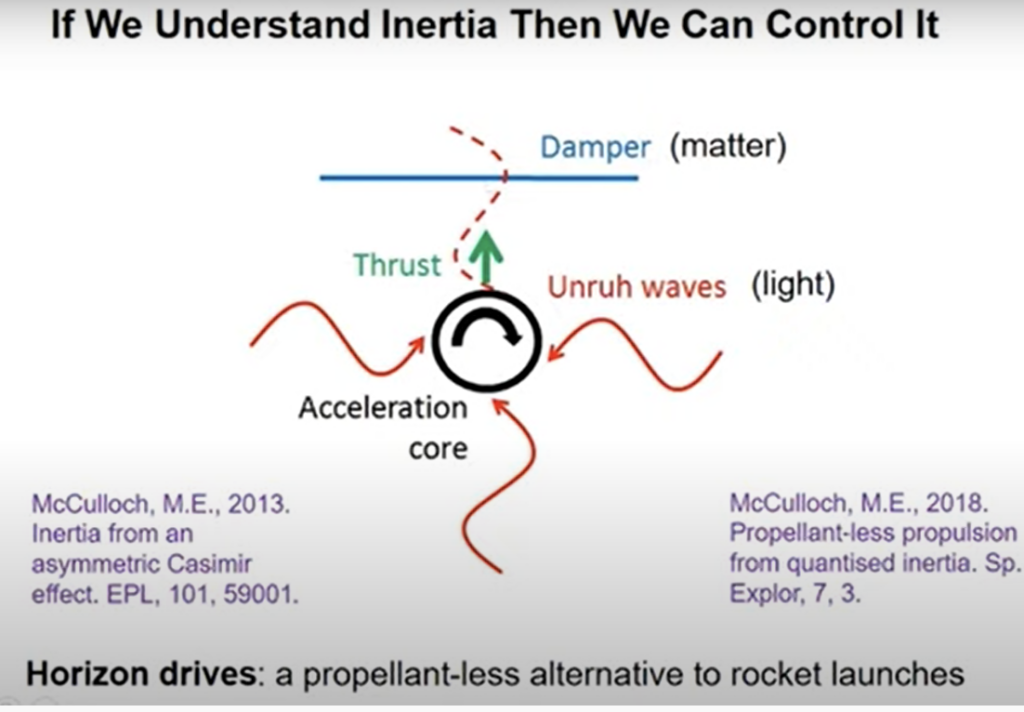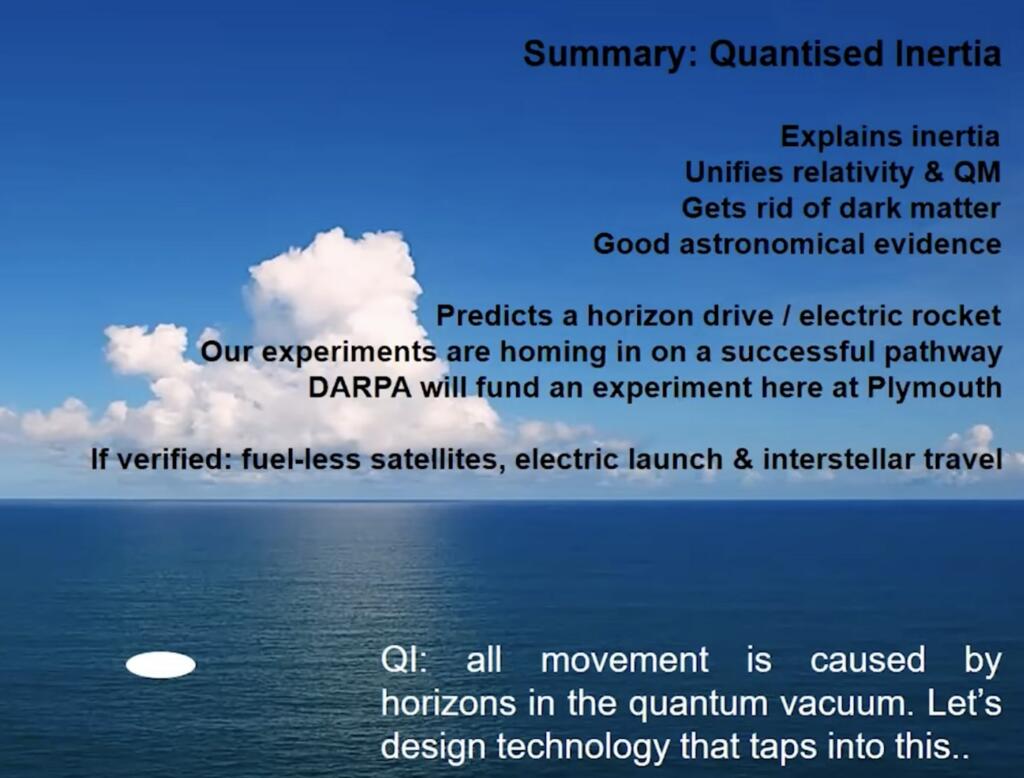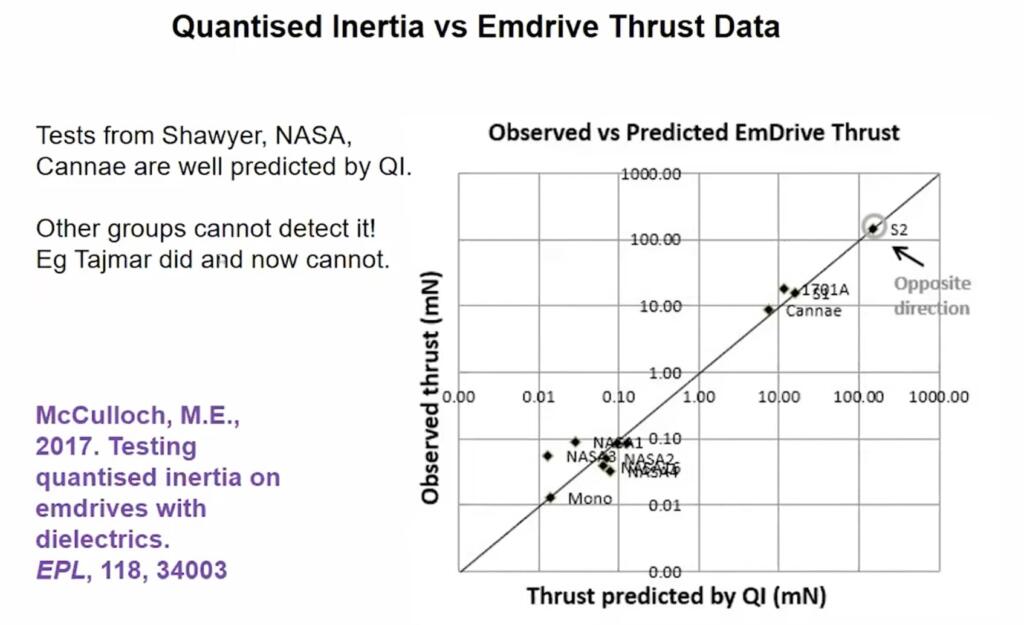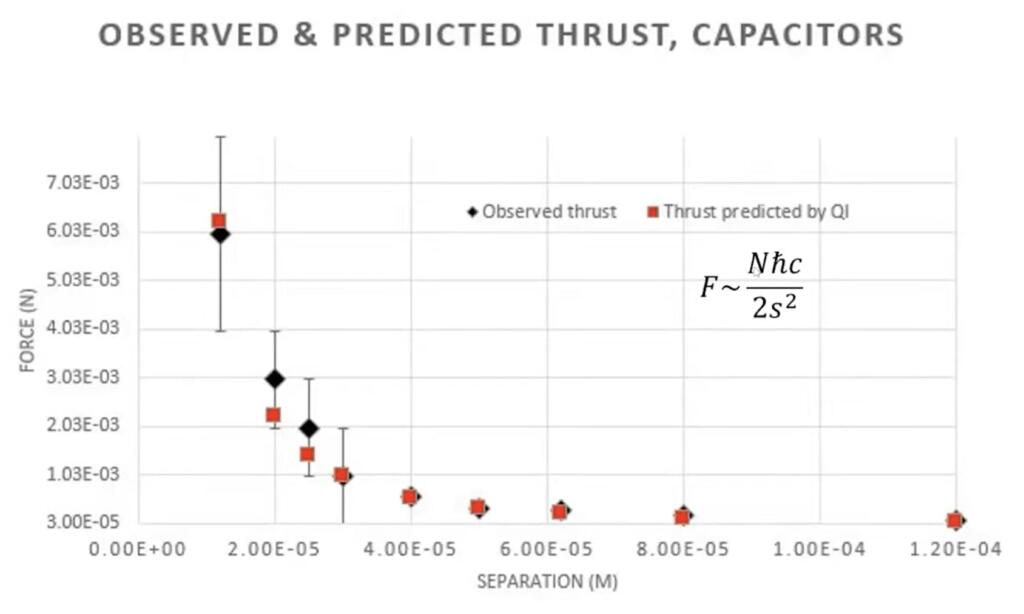Richard Mansell, Chief Executive Officer at IVO Limited gave the reasons he is optimistic about the Quantum Space Drive tests that will be done in orbital microgravity.
The DARPA funding (2018-2022 Quantized Inertia investigation) $1.3 million was for the researcher Mike McCulloch. But none of the DARPA funding has been or is yet for IVO. IVO is all privately funded. No VC or DARPA funds. The $17 Million DARPA Otter which appears intended for this type of work, but nothing has been allocated to my knowledge and definitely no DARPA funds have gone to IVO.
IF the orbital test works then it will lead to interstellar travel and shrinking it down would give material that would have anti-gravity like effects. We would spend the money to make nanocavities so that we could have propellentless thrust for floating cities. All of space and propulsion related science fiction would become possible within about three decades short of faster than light. This drive is in orbit now for a few months. I think DARPA gave them more money to conclusively prove if it works or not. All of the ground tests show it might work. But if it proves out then we first get 1000 times better than a hall effect thruster but with no fuel limit. No fuel is used. So long as you have power, solar or nuclear the drive keeps working. So nuclear fuel supply for decades then thrust for decades. The theory proves out, then we make nanocavities which could act like antigravity then we get 1G or even 3G thrusters in space. This would be the Expanse TV show tech. 2 days to Mars using constant 2G acceleration.
Here are details of IVO quantized inertia propulsion system. Lasers fired into precisely sized metal cavities with precise geometry chambers have gotten positive results in about 5 out of 6 labs.
Continued Presentation of Discussion of Quantized Inertia From TED Talk and Other Science Presentations
Constant 1G acceleration is the rightmost column in the table below. 1G constant acceleration gets to Uranus in 24 days.

It is based upon a theory known as Quantized Inertia (QI). They have launched the device into orbit to test if can operate as a propellant-less engine. If they did years of careful testing on Earth there would always be doubts that they had checked everything. A rideshare into orbit on SpaceX cost about $350000 on top of whatever the device cost plus the extra costs of making the system ready for space.
A budget of about $3 million will conclusive prove if the system works. IF it changes the orbit and is hundreds of times more powerful than a Hall Effect thruster then our world will change. It would not be years and years of getting more vacuum chambers and doing tests that would have doubters. If the orbit is changed then the system is useful. No outgassing or thermal effects will have the effect they are expecting to see.
Quantized Inertia (QI), which was first proposed in 2007 by Mike McCulloch at Plymouth University.














U.S. wireless power company IVO Ltd. launched its first all-electric satellite propulsion system as part of the Transporter 9 mission. IVO says the launch was successful, and the team established contact with its satellite, the Barry-1, on Monday. Speaking with The Debrief, the company’s founder Richard Mansell says his device relies on the principle of QI (i.e. doesn’t require propellant for thrust), but uses different technologies than the EmDrive. The first design of a resonant cavity thruster claiming to be a reactionless drive was by Roger Shawyer in 2001.
The satellite’s testing program includes a 60-day resting period post-launch to stabilize its orbit, accounting for initial perturbations such as outgassing. Subsequently, the experimental drive is planned to be activated, with its effects observable through public satellite tracking services.
As of January 2024, there have been no public statements from either Rogue Space Systems or IVO Limited regarding the performance of the experimental propulsion system. Independent analysis of the satellite’s TLE data indicates a gradual decay in its orbital altitude.
IVO claims that its engine can get 52 millinewtons (mN) of thrust from just one watt of electricity. If true, that’s a huge step up from Hall-Effect thrusters (also known as ion thrusters), which have an overall lower energy efficiency. The Quantum Drive is also only 300 grams, whereas an ion engine can weigh upward of 200 kilograms. Hall thrusters have a thrust-to-power ratio of about 60 mN/kW. The IVO would be nearly 1000 times more powerful for the same power as Hall Effect Thruster.
The Barry-1 contains a pair of Quantum Drives has now orbited Earth for a few weeks to establish baseline data before the satellite tries to change its orbit using its onboard quantum drives.
Reasons the team is optimistic about IVO LTD’s upcoming Quantum Drive space tests:
1. They conducted null tests. With our null tests, everything was the same as regular tests, but a single physical factor was changed within the Drive so as to negate any #QI predicted thrust. The current going through all the wires was the same. The voltages throughout the system was the same. No thrust was observed! No thrust during null tests = not seeing false positives.
In other words, if any of the observed thrust (during standard testing) was due to any force other than #QI (such as corona discharge, Lorentz Force, heating of components, etc.), we should still have observed some thrust. They didn’t! Therefore they had to conclude the thrust was due to Quantized Inertia.
2.They saw no more thrust in terrestrial vacuum chamber tests than expected as predicted by Mike McCulloch’s #QI. If they had measured more thrust than expected, it would be a good sign of a false positive.
In fact the measured thrust was slightly less than the #QI predicted thrust as would be expected from natural system losses (non-mathematical ideals).
3. They were able to eliminate all known false positives found in non-conventional thruster tests. These would be those such as from M Tajmar and colleagues’ work. Here are links to some of the papers we referenced to check and make sure we weren’t overlooking some form of false positive:
The EMDrive elimination of false positives by Tajmar.(2021)

The IVO Team told Universe Today
The Quantum Drive was tested and the thrust was measured within high vacuum chambers (down to 4×10-6 Torr) in multiple configurations to eliminate possible artifact forces such as electromagnetic, electrostatic, Lorentz, Corona discharge, ion wind, etc. Control Drives were also produced to provide baseline measurements. All test setups were evaluated by third-party individuals. All Quantum Drives showed thrust consistent with predicted Quantized Inertial calculations. Control Drives confirmed that thrust measurements were not consistent with any other known forces.
The IVO Quantum Drive really is a total departure from the current limitations of modern space propulsion. It is the first pure electric propulsion device, meaning it requires only electricity to run. Gone are the days of complex fuel systems which require special fuel solutions to propel the spacecraft. As long as we have electricity, we have thrust, which is why unlimited Delta-V is possible for the first time ever. Due to its self-contained nature, this is the first propulsion device that can be completely internal to a spacecraft.
The self-contained thruster can also be mounted in any orientation, offering up to 6 degrees of freedom. Eliminating propellants would also eliminate the need for bulky and heavy storage tanks, reducing a spacecraft’s overall mass and increasing its payload capacity. Lastly, a propulsion system that doesn’t require propellant removes the need for satellite refueling or deorbiting due to fuel limitations. Said Telehey, these advantages “will drive the most dramatic shift in terms of cost reduction that the space industry has ever seen

Brian Wang is a Futurist Thought Leader and a popular Science blogger with 1 million readers per month. His blog Nextbigfuture.com is ranked #1 Science News Blog. It covers many disruptive technology and trends including Space, Robotics, Artificial Intelligence, Medicine, Anti-aging Biotechnology, and Nanotechnology.
Known for identifying cutting edge technologies, he is currently a Co-Founder of a startup and fundraiser for high potential early-stage companies. He is the Head of Research for Allocations for deep technology investments and an Angel Investor at Space Angels.
A frequent speaker at corporations, he has been a TEDx speaker, a Singularity University speaker and guest at numerous interviews for radio and podcasts. He is open to public speaking and advising engagements.


Problem is the host satellite Barry-1 isn’t done with commissioning yet, so they haven’t even started the IVO thruster tests
In one SF novel (Genesis by Poul Anderson) there is a short scene in a simulation of an alternate earth in which humans have a roughly 20th century tech level. They are totally baffled that their rockets being launched into orbit disappear above a certain height. All their calculations say the rockets should go into orbit.
I swear, I’m almost tempted to invent some BS space drive myself, and hop on the gravy train.
With this kind of money out there for reactionless drives, why isn’t anybody building a Loftstrom launch loop, which doesn’t even require novel physics, just perfectly ordinary engineering?
Yes. It is a disgrace that bull…t like this is pushed and financed. It all boils down to scientific illiteracy. It is exactly like saying “if magic carpets could fly we could use them to send stuff tu mars, please pay me millions si that i can verify if my loom can produce magic carpets…
Agreed. Extraordinary claims require extraordinary evidence.
Thus putting the drive into orbit and trying to move the satellite 100 kilometers or more. Extraordinary evidence.
They’ve been up for 75 days. LEOP is typically a week give or take a few days.
So … for the more Science people here
Léts say
𝒌 = F/P … [1] force divided by power (eg. 100 N per kW)
F = 𝒌P … by rearrangement
And some basic physics
F = ma … [2] force (N) = mass (kg) times accel (m/s²)
E = Fd … [3] energy = force times distance
d = vt … [4] distance = velocity times time.
Put these together as we get
E = Fvt … [3] & [4]
P = E/t … [5] power = energy divided by time
P = Fvt/t … subst in above, cancel (t)
P₁ = Fv … subst in rearranged [1]
P₁ = 𝒌P₀v
Here, P₁ is output power, and P₀ is input power. More rearrangement
P₁ / P₀ = 𝒌v
If we define ‘break-even’ as [P₁ / P₀ = 1.0], or where output power is equal to input power, and any velocity greater than that produces EXCESS power, then
1 = 𝒌v … rearranging
v = 1/𝒌
THAT is the “becomes perpetual motion machine” point.
So Léts put this to real numbers. The author has glibly reckoned that they can get a hundred newtons per kilowatt of input. This is a (𝒌 = 100 ÷ 1000 → 0.1) figure of merit. OK! Then by our little math work previously, then
v = 1/(𝒌 = 0.1)
v = 10
At more than 10 meters per second, the whole contraption would generate MORE energy (as kinetic energy) than invested into its thruster. 10 m/s isn’t very fast; one could conjure up large flywheels with these devices on the rim to provide the thrust well in excess of invested energy to make never-ending electricity generators. Brilliant!
The space travel gambit is sure sexy-enough-to-get-millions of investment monies. But the real money is in having huge flywheels making FREE energy, down here on Planet Dirt. Us babbling Terrans could use a whole lot of free energy.
________________________________________
In short, this doesn’t pass the Free Energy sniff test.
⋅-⋅-⋅ Just saying, ⋅-⋅-⋅
⋅-=≡ GoatGuy ✓ ≡=-⋅
Unfortunately McCulloch comes across as mostly a Right Wing nut job in his X posts, but I’m willing to admit that isn’t incompatible with his being right about this, just not encouraging.
Mike Griffin’s plan could physically work at least.
Can they be scaled up or used in parallel for a Space Station or SpaceX Starship?
Yes, it can….
Watch the attached video. If proven to work, the effect can be scaled up.
https://www.youtube.com/watch?v=fnNKC82wUmY&t=21s
IVO Limited tracking of BARRY-1 from their website:
https://db.satnogs.org/satellite/QDDY-8878-5291-1819-3935#mapcontent
Hope springs eternal and the Kraken drives are always sneaking in the dark.
If it works, it will probably explain a lot of anomalies barely on the threshold of measurement.
And it will break all our civilization assumptions about future growth and development. These drives can easily generate enough energy to create galactic black holes, by giving us the ability of increasing energy density exponentially in a quadratic growing space.
For me at least, it would be a sign that we live indeed in a simulation, by finding the analogous of the Kerbal Space Program’s Kraken drives, exploiting errors in the game engine to get “free energy” and ludicrous acceleration.
For the moment, tho’, I will hold to conservation of energy and momentum until being thoroughly proved wrong. It has proven a safe bet so far.
The powers-that-be are probably uploading a patch to the simulator right now.